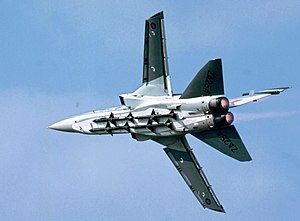| Skyflash | |
|---|---|
 Prototype Panavia Tornado ADV aircraft with semi-recessed Skyflash missiles | |
| Type | Medium-range air-to-air missile |
| Place of origin | United Kingdom |
| Service history | |
| In service | 1978–2006 |
| Production history | |
| Designer | Hawker Siddeley, Marconi Space & Defence Systems |
| Manufacturer | BAe Dynamics |
| Unit cost | £150,000 per missile |
| Specifications | |
| Mass | 193 kg (425 lb) |
| Length | 3.68 m (12 ft 1 in) |
| Diameter | 203 mm |
| Wingspan | 1.02 m (3 ft 6 in) |
| Warhead | 39.5 kg (87 lb) |
| Engine | Rocketdyne solid propellant rocket motor |
Operational range | 45 km (28 mi) |
| Maximum speed | Mach 4 |
Guidance system | Marconi inverse monopulse semi-active radar homing |
The Skyflash, or Sky Flash in marketing material, was a medium-range semi-active radar homing air-to-air missile derived from the US AIM-7 Sparrow missile and carried by Royal Air Force McDonnell Douglas F-4 Phantoms and Tornado F3s, Italian Aeronautica Militare and Royal Saudi Air Force Tornados and Swedish Flygvapnet Saab Viggens.
Skyflash replaced the original Raytheon conical scanning seeker with a Marconi inverse monopulse seeker that worked with the F-4's radar. Monopulse seekers are more accurate, less susceptible to jamming, and able to easily pick out targets at low altitudes. It offered significantly better performance than the original seeker, allowing British Aerospace to dispense with upgrades to the warhead that were carried out in the US to address poor accuracy.
Skyflash was tested in the US, but after trials against experimental monopulse seekers from Raytheon, the United States Navy elected to order a different monopulse-equipped version of the Sparrow, the AIM-7M. Both Skyflash and AIM-7M were later replaced by the more capable AMRAAM.